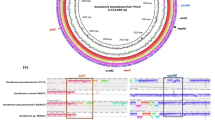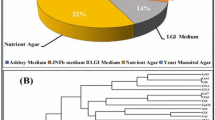Abstract
Cultural, physiological and biochemical properties of 18 strains of rhizobia isolated from root nodules of the forage legume H. spinosissimum were compared with those of rhizobia from the related species H. coronarium (15 strains) and H. flexuosum (four strains). On the basis of 43 characteristics the 37 strains of Hedysarum rhizobia could be divided into two groups by numerical analysis. The H. spinosissimum rhizobia formed the first group and the second group comprised the strains from H. coronarium and H. flexuosum. The reference Rhizobium leguminosarum bv. viceae strain 250A was clustered with the rhizobia from H. coronarium and H. flexuosum. By contrast Bradyrhizobium sp. (Arachis) reference strain 280A was not clustered with any of the strains tested, indicating that the H. spinosissimum rhizobia differ from both Rhizobium and Bradyrhizobium. Serological data also discriminate between H. spinosissimum and H. coronariumrhizobia but not between the latter and H. flexuosum strains. The strains tested exhibit a high degree of specificity for nodulation and nitrogen fixation. We also determined the16SrRNA gene sequence of H. spinosissimum rhizobia (four strains), H. coronarium (two strains) and H. flexuosum (two strains) and found that the four H. spinosissimum isolates share a 98% identity among each other in this region but they showed less than 92% identity to the H. coronarium and H. flexuosum isolates. The H. spinosissimum isolates were closely related to both Mesorhizobium loti and M. ciceri, sharing 97% identity with each species.
Similar content being viewed by others
References
Allen O N and Allen E K 1981 The Leguminosae. Univ. of Wisconsin Press, Madison, WI, USA. 812 pp.
Bieleski R L 1973 Phosphate pools, phosphate transport and phosphate availability. Annu. Rev. Plant Physiol. 24, 225–252.
Beringer J E 1974 R factor transfer in Rhizobium leguminosarum. J. Gen. Microbiol. 84, 188–198.
Cadahia E, Leyva A and Ruiz-Argueso T 1986 Indigenous plasmids and cultural characteristics of rhizobia nodulating chickpeas (Cicer arietinum L.) Arch. Microbiol. 146, 239–244.
Eardly B W, Young J P W and Selander R K 1992 Phylogenetic position of Rhizobium sp. Strain Or101, a symbiont of both Medicago sativa and Phaseolus vulgaris, based on partial sequences of the 16S rRNA and nifH Genes. Appl. Environ. Microbiol. 58, 1809–1815.
Engvall E and Perlmann P 1971 Enzyme-linked immunosorbent assay (ELISA). Quantitative assay of immunoglobulin G. Immunochemistry 8, 871–874.
Felsenstein J 1989 PHYLIP-phylogeny inference package (vertion 3.2). Cladistics 5, 164–166.
Graham P H and Parker C A 1964 Diagnostic features in the characterisation of root-nodule bacteria of legumes. Plant Soil 20, 383–396.
Graham P H, Sadowsky M J, Keyser H H, Barnet Y M, Bradley R S, Cooper J E, De Ley D J, Jarvis B D W, Roslycky E B, Strijdom B W and Young J P W 1991 Proposed minimal standards for the description of new genera and species of root-and stem-nodulating bacteria. Int. J. Syst. Bacteriol. 41: 582–587.
Gurfel D, Lobel R and Schiffmann J 1982 Symbiotic nitrogen-fixing activity and yield potential of inoculated H. coronarium in Israel. Isr. J. Bot. 31, 296–304.
Hely F W and Ofer I 1972 Nodulation and frequencies of wild leguminous species in the Northern Negev region of Israel. Aust. J. Agric. Res. 23, 267–284.
Howieson J G, Ewing M A and D'Antuono M F 1988 Selection for acid tolerance in Rhizobium meliloti. Plant Soil 105, 179–88.
Howieson J G, Malden J, Yates R J and O'Hara G 2000 Techniques for the selection and development of elite inoculant strains of Rhizobium leguminosarum in Southern Australia. Symbiosis 28, 33–48.
Jordan D C 1984 Family III Rhizobiaceae Conn 1938. In Bergeys Manual of Systematic Bacteriology. Vol 1. Eds. N R Krieg and J G Holt. pp. 234–254. Williams and Wilkins, Baltimore, MD, U.S.A.
Kernick M D 1978 Indigenous arid and semiarid forage plants of North Africa, the Near and Middle East. In Ecological Management of Arid and Semi-arid Rangelands in Africa, and the Near and Middle East, Vol. IV, pp. 599–619. FAO, Rome, Italy.
Kimura M 1980 A simple model for estimating evolutionary rates of base substitutions through comparative studies of nucleotide sequences. J. Mol. Evol. 16: 111–120.
Kishinevsky B and Gurfel D 1980 Evaluation of enzyme-linked immunosorbent assay (ELISA) for serological identification of different Rhizobium strains. J. Appl. Bacteriol. 49, 514–526.
Kishinevsky B and Maoz A 1983 ELISA identification of Rhizobium strains by use of enzyme-labeled protein A. Curr. Microbiol. 2, 45–49.
Kishinevsky B D Sen D and Guang Yang 1996 Diversity of rhizobia isolated from various Hedysarum species. Plant Soil 186, 21–28.
Leung K and Bottomley P J 1987 Influence of phosphate on the growth and nodulation characteristics of Rhizobium trifolii. Appl. Envir. Microbiol. 53 (9) 2098–2105.
Lindstrom K, Laguerre G, Normand P, Rasmussen U, Heulin T, Jarvis B D W, de Lajudie P, Martinez-Romero E and Chen W X 1998 Taxonomy and Phylogeny of Diazotrophs. In Biological Nitrogen Fixation for the 21st Century. Eds C Elmerich, A Kondorosi and W E Newton. pp. 559–570. Kulwer Academic Publishers, Dordrecht, The Netherlands.
Nandasena K G, O'Hara G W, Tiwari R P, Yates R Y and Howieson J G 2001 The phylogenetic relationships of three bacteria strains isolated from the pasture legume Biserrula pelecinus L. Int. J. Syst. Evol. Microbiol. 51, 1983–1986.
Nour S M, Cleyet-Marel J C, Beck D, Effosse A and Fernandez M P 1994 Genotypic and phenotypic diversity of Rhizobium isolated from chickpea (Cicer arietinum L). Can. J. Microbiol. 40, 345–354.
Novikova N I, Pavlova E A, Vorobjev N I and Limeshchenko E V 1994 Numerical taxonomy of Rhizobium strains from legumes of the temperate zone. Int. J. Syst. Bacteriol. 734–742.
Prevost D, Borbeleau L M, Caudry-Reznick S, Shulman H M and Antoun H 1987 Characteristics of rhizobia isolated from three legumes indigenous to the Canadian high Arctic: Astragalus alpinus, Oxytropis maydelliania and Oxytropis arctobia. Plant Soil 98, 313–324.
Reeve W G, Tiwari R P, Dilworth M J and Glenn A R 1997 A helicase gene (helO) in Rhizobium meliloti WSM419. FEMS Microbiol Lett. 153: 43–49.
Saitou N and Nei M 1987 The neighbour-joining method: a new method for reconstructing phylogenetic trees. Mol. Biol. Evol. 4, 406–425.
Smart J B, Robson A D and Dilworth M J 1984 A continuous culture study of phosphorus nutrition of Rhizobum trifolii Wu95, Rhizobium NGR234 and Bradyrhizobium CB756. Arch. Microbiol. 140, (2–3), 276–280.
Somasegaran P and Hoben H J 1994 Handbook for Rhizobia: methods in Legume-Rhizobium Technology. Springer, New York. 450 pp.
Sprent J I 2001 Nodulation in legumes. Royal Botanic Gardens, Kew
Stowers M D and Eaglesham A R J 1984 Physiological and symbiotic characteristics of fast-growing Rhizobium japonicum. Plant Soil 77, 3–14.
Van Berkum P, Beyene D and Eardly B D 1996 Phylogenetic relationships among Rhizobium species nodulating the common bean (Phaseolous vulgaris L.). Int. J. Syst. Bacteriol. 46, 240–244.
Vincent J M 1970 A Manual for the Practical Study of the Root Nodule Bacteria. Blackwell Scientific Publications, Oxford.
Willems A and Collins M D 1993 Phylogenetic analysis of rhizobia and agrobacteria based on 16S rRNA gene sequences. Int. J. Syst. Bacteriol. 43: 305–313.
Yanagi M and Yamasato K 1993 Phylogenetic analysis of the family Rhizobiaceae and related bacteria by sequencing of 16S rRNA gene using PCR and DNA sequencer. FEMS Microbiol. Lett. 107, 115–120.
Yates R J, Howieson J G and Carr S J 1996 The role of root-nodule bacteria in the adaptation of two long lived forage legumes from the Mediterranean basin to Western Australia. In The Eleventh Australian Nitrogen Fixation Conference. The University of Western Australia Nedlands, Western Australia.
Young J P W 1996 Phylogeny and taxonomy of rhizobia. Plant Soil 186, 45–52.
Young J P W, Downer H L and Eardly B D 1991 Phylogeny of the phototrophic Rhizobium strain BTAil by polymerase chain reaction-based sequencing of a 16S rRNA gene segment. J. Bacteriol. 173, 2271–2277.
Author information
Authors and Affiliations
Corresponding author
Rights and permissions
About this article
Cite this article
Kishinevsky, B.D., Nandasena, K.G., Yates, R.J. et al. Phenotypic and genetic diversity among rhizobia isolated from three Hedysarum species: H. spinosissimum, H. coronarium and H. flexuosum . Plant and Soil 251, 143–153 (2003). https://doi.org/10.1023/A:1022967213088
Issue Date:
DOI: https://doi.org/10.1023/A:1022967213088




